Canada, with its vast landscapes, pristine lakes, and breathtaking coastlines, is a paradise for outdoor enthusiasts. Among the many activities that allow you to immerse yourself in Canada's natural beauty, kayaking stands out as one of the most rewarding. Whether you're a seasoned paddler or a beginner looking for a serene escape, kayaking in Canada offers an unparalleled experience. As we look ahead to 2025, we’ve curated a list of the 10 Best Places To Kayak In Canada that you simply cannot miss. From tranquil lakes to rugged coastlines, these destinations promise unforgettable adventures. So, grab your paddle, and let’s dive into the best spots to kayak in Canada!
🚣♂️ Best Places To Kayak In Canada
Table of contents
- 🚣♂️ Best Places To Kayak In Canada
- 🌊 1. Banff National Park, Alberta
- 🌊 2. Pacific Rim National Park Reserve: A Kayaker’s Paradise on Canada’s West Coast
- 🌊 3. Algonquin Provincial Park: A Kayaker’s Dream in Ontario’s Wilderness
- 🌊 4. Gros Morne National Park: A Kayaking Adventure in Newfoundland’s Untamed Wilderness
- 🌊 5. Thousand Islands: A Kayaking Paradise in Ontario’s St. Lawrence River
- 🌊 6. Clayoquot Sound: A Kayaker’s Paradise on Vancouver Island’s Wild Coast
- 🌊 7. Jasper National Park: A Kayaking Adventure in the Heart of the Canadian Rockies
- 🌊 8. Bay of Fundy: A Kayaking Adventure with the World’s Highest Tides
- 🌊 9. Rideau Canal: A Serene Kayaking Journey Through Ontario’s Historic Waterway
- 🌊 10. Haida Gwaii: A Remote Kayaking Adventure in Canada’s Pacific Edge
- 🌟 10 Best Places To Kayak In Canada: In Conclusion
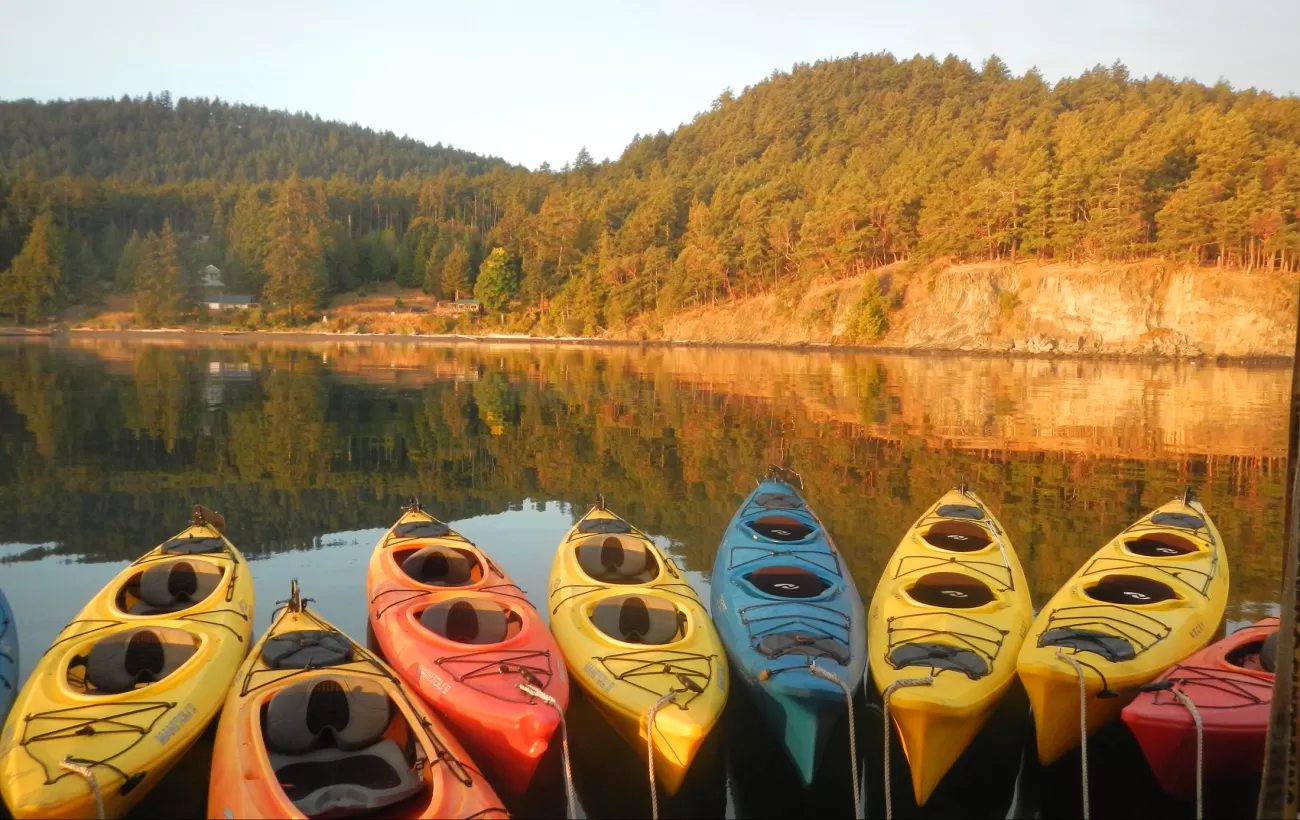
Disclosure: Some links in this post are affiliate links. If you make a purchase through one of these links, we may earn a small commission (at no extra cost to you!). We're very grateful when you use our links to make a purchase:-).
🌊 1. Banff National Park, Alberta
Banff National Park is a crown jewel of Canada’s natural wonders and a top destination for kayaking enthusiasts. Located in the heart of the Canadian Rockies, this UNESCO World Heritage Site is home to some of the most stunning landscapes on the planet. The park’s crystal-clear lakes, surrounded by towering mountain peaks and lush forests, create a kayaking experience that feels almost otherworldly.
Why Kayak in Banff National Park?

- Iconic Lakes: The turquoise waters of Lake Louise and Moraine Lake are world-famous for their breathtaking beauty. Paddling here feels like gliding through a dream, with the surrounding mountains reflecting perfectly on the calm waters.
- Diverse Waterways: Beyond the famous lakes, Banff offers a variety of paddling options. Bow Lake and Johnson Lake are quieter alternatives, perfect for those seeking a more peaceful experience.
- Wildlife Encounters: Keep an eye out for wildlife as you paddle! It’s not uncommon to spot elk, deer, or even bears along the shoreline.
- Accessibility: Many of Banff’s lakes are easily accessible, making it a great destination for both beginners and experienced kayakers.
Find the best hotel deals for your next trip! Compare prices and book your stay on
HostelWorld (Amazing Hostels & Hotels around the world)
TripAdvisor (Compare hotels, read real reviews, and find the best prices)
Top Kayaking Spots in Banff
Lake Louise: The Crown Jewel of Banff National Park
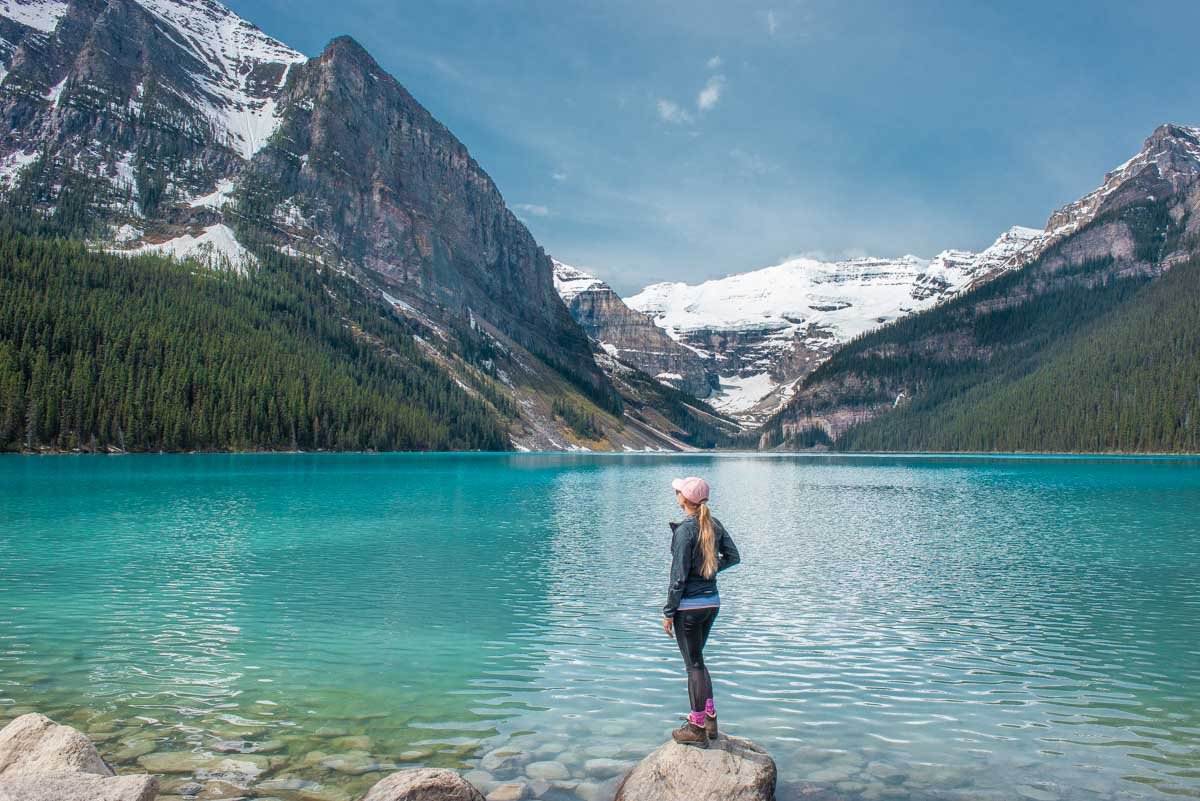
Lake Louise is undoubtedly one of the most iconic and breathtaking destinations in Canada, and it’s a must-visit for anyone planning to kayak in Banff National Park. Known for its stunning turquoise waters, dramatic mountain backdrop, and serene atmosphere, Lake Louise is a paddler’s paradise. Whether you’re a seasoned kayaker or a beginner, this glacial lake offers an unforgettable experience that will leave you in awe of nature’s beauty.
Why Kayak on Lake Louise?
- Unmatched Scenery: The vibrant turquoise color of the lake, caused by glacial rock flour, is unlike anything you’ve ever seen. The surrounding peaks, including Mount Victoria and the Victoria Glacier, create a dramatic backdrop that’s perfect for photos and memories.
- Tranquility: Despite being a popular destination, the lake’s vast size ensures that you can find peaceful spots to paddle and soak in the serenity.
- Accessibility: The lake is easily accessible, with a well-maintained shoreline and rental facilities nearby.
- Wildlife: While paddling, you might spot wildlife like bald eagles, pikas, or even grizzly bears in the distance.
What Makes Lake Louise Special?
- Glacial Origins: Lake Louise is fed by glacial meltwater, which gives it its signature turquoise hue. The water is cold year-round, so swimming is not recommended, but kayaking is the perfect way to experience the lake’s beauty.
- Spirit of Adventure: Named after Princess Louise Caroline Alberta, the lake has a rich history and has been a destination for explorers and adventurers for over a century.
- Year-Round Beauty: While kayaking is a summer activity, Lake Louise transforms into a winter wonderland, offering ice skating and snowshoeing opportunities.
Best Time to Kayak on Lake Louise
The best time to kayak on Lake Louise is during the summer months (June to September) when the weather is warm, and the lake is free of ice. Early mornings are ideal for calm waters and fewer crowds. By mid-morning, the lake can get busy with tourists, so aim to start your paddle early to enjoy the tranquility.
Kayaking Tips for Lake Louise
- Rentals: If you don’t have your own kayak, you can rent one from the Lake Louise Boathouse. They offer hourly rentals for kayaks, canoes, and stand-up paddleboards.
- Permits: No special permits are required for kayaking, but you’ll need a Parks Canada Pass to enter Banff National Park.
- Safety: Always wear a life jacket, even if you’re an experienced paddler. The water is cold, and conditions can change quickly in the mountains.
- Photography: Don’t forget your camera or phone! The reflections of the mountains on the lake’s surface are a photographer’s dream.
What to Do Around Lake Louise
While kayaking is the highlight, there’s plenty more to explore in the area:
- Hiking: The Lake Louise Lakeshore Trail is an easy, family-friendly hike that offers stunning views of the lake. For a more challenging adventure, try the Plain of Six Glaciers Trail or the Big Beehive Hike.
- Dining: Enjoy a meal at the Fairview Bar & Restaurant in the Fairmont Chateau Lake Louise, offering gourmet cuisine with a view.
- Photography: The Lake Louise Viewpoint is a popular spot for capturing the lake’s beauty.
Find the best hotel deals for your next trip! Compare prices and book your stay on
HostelWorld (Amazing Hostels & Hotels around the world)
TripAdvisor (Compare hotels, read real reviews, and find the best prices)
Why Lake Louise is a Must-Visit in 2025
Lake Louise is more than just a kayaking destination—it’s a place where nature’s beauty takes center stage. Whether you’re gliding across its turquoise waters, hiking through the surrounding trails, or simply soaking in the views, Lake Louise offers an experience that’s both exhilarating and peaceful.
As you plan your 2025 kayaking adventures, make sure Lake Louise is at the top of your list. It’s not just a place to visit; it’s a place to remember forever.
Moraine Lake: The Jewel of the Canadian Rockies
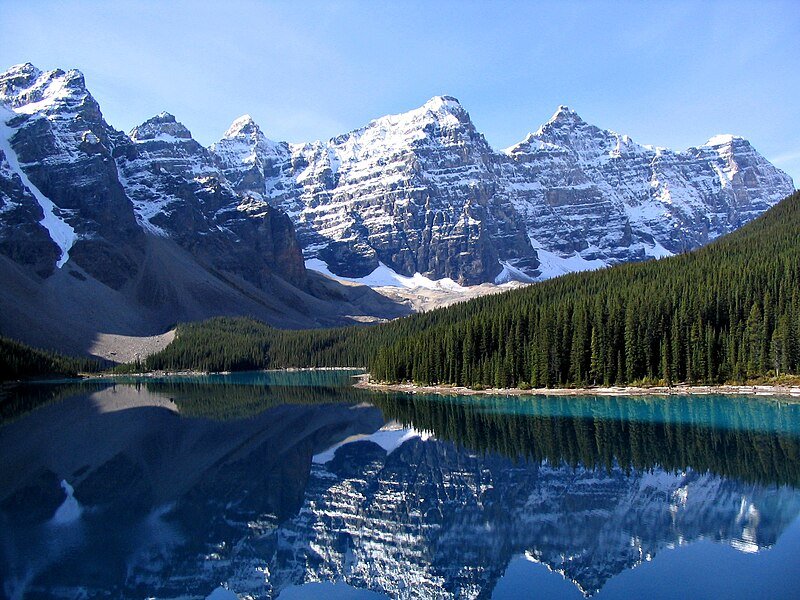
Moraine Lake, often referred to as the "Jewel of the Canadian Rockies," is one of the most iconic and breathtaking destinations in Canada. Located in Banff National Park, just a short drive from Lake Louise, this glacially-fed lake is renowned for its vibrant blue waters, dramatic mountain scenery, and serene atmosphere. For kayakers, Moraine Lake offers an unforgettable paddling experience that combines natural beauty, tranquility, and adventure.
Why Kayak on Moraine Lake?
- Stunning Scenery: The lake’s vivid blue color, caused by light refracting off glacial rock flour, is mesmerizing. Surrounded by the Valley of the Ten Peaks, the views are nothing short of spectacular.
- Peaceful Atmosphere: While Moraine Lake is a popular destination, its smaller size compared to Lake Louise makes it feel more intimate and serene.
- Photography Paradise: The reflections of the Ten Peaks on the lake’s surface create some of the most iconic images of the Canadian Rockies.
- Wildlife Spotting: Keep an eye out for wildlife like marmots, pikas, and even grizzly bears in the surrounding area.
What Makes Moraine Lake Special?
- Glacial Origins: Like Lake Louise, Moraine Lake is fed by glacial meltwater, which gives it its stunning blue hue. The lake is at its most vibrant in late spring and early summer when the glaciers are actively melting.
- The Valley of the Ten Peaks: The lake is framed by ten towering peaks, each over 3,000 meters high, creating a dramatic and awe-inspiring backdrop.
- Remote Beauty: Moraine Lake feels more secluded than Lake Louise, offering a sense of tranquility and connection with nature.
Best Time to Kayak on Moraine Lake
The best time to kayak on Moraine Lake is during the summer months (June to September) when the lake is free of ice and the weather is warm. However, the lake is only accessible from late May to early October due to road closures during the winter months. Early mornings are ideal for calm waters and fewer crowds.
Kayaking Tips for Moraine Lake
- Rentals: Kayak rentals are not available directly at Moraine Lake, so you’ll need to bring your own kayak or rent one from nearby locations like Lake Louise.
- Permits: No special permits are required for kayaking, but you’ll need a Parks Canada Pass to enter Banff National Park.
- Safety: Always wear a life jacket, as the water is cold and conditions can change quickly in the mountains.
- Parking: Moraine Lake’s parking lot fills up quickly, especially during peak season. Arrive early (before 6 AM) or use the Parks Canada shuttle from Lake Louise to avoid parking hassles.
Book top-rated tours and attractions on :
Viator (Best for curated global tours)
GetYourGuide (Skip-the-line tickets & local guides)
Klook (Great for Asia adventures & discounts)
What to Do Around Moraine Lake
While kayaking is the highlight, there’s plenty more to explore in the area:
- Hiking: The Rockpile Trail is a short but rewarding hike that offers one of the most iconic views of Moraine Lake. For a more challenging adventure, try the Larch Valley Trail or the Sentinel Pass Hike.
- Photography: The viewpoint from the Rockpile is one of the most photographed spots in Canada. Don’t forget your camera!
- Picnicking: Enjoy a picnic by the lake and soak in the stunning views.
Need a ride? Book airport transfers, taxis, or rental cars easily:
Kiwitaxi (Reliable private transfers worldwide)
Rentalcars.com (Compare car rentals for the best price)
Why Moraine Lake is a Must-Visit in 2025
Moraine Lake is more than just a kayaking destination—it’s a place where nature’s beauty takes your breath away. Whether you’re paddling across its vibrant blue waters, hiking through the surrounding trails, or simply sitting by the shore and taking in the views, Moraine Lake offers an experience that’s both exhilarating and peaceful.
Bow Lake: A Hidden Gem in Banff National Park
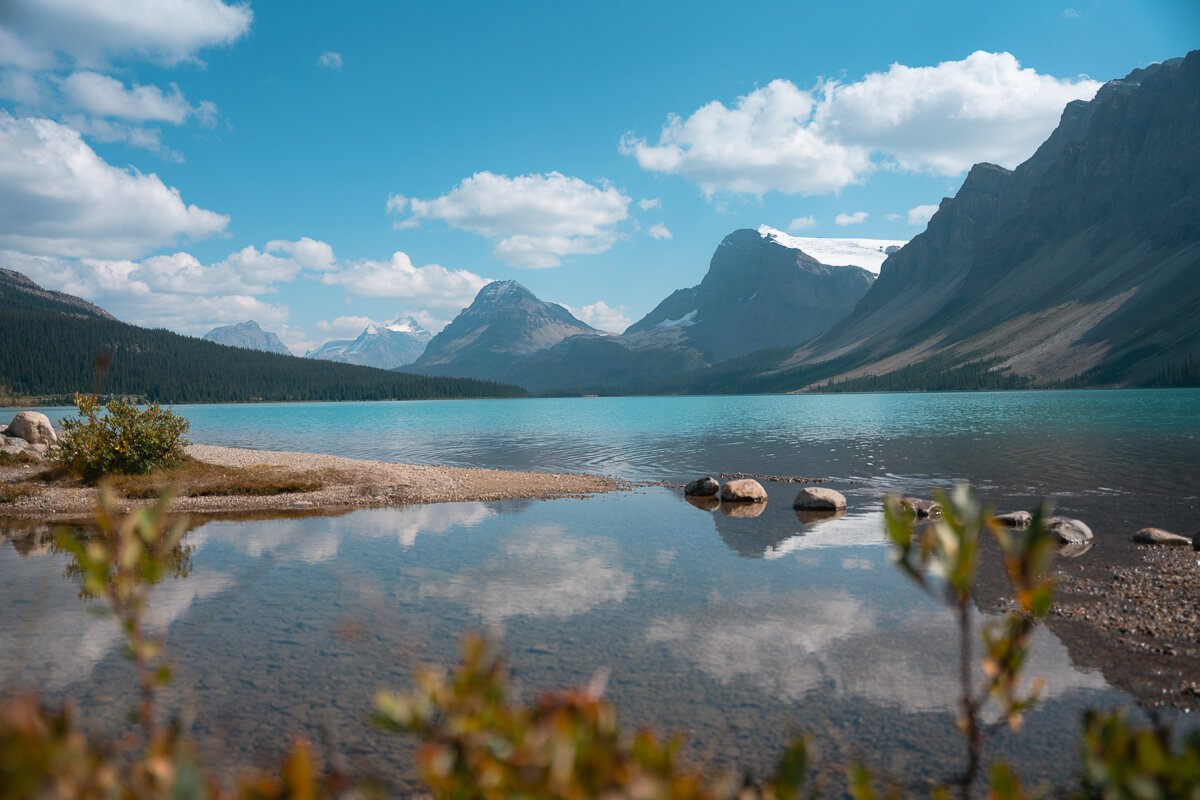
Bow Lake is one of Banff National Park’s most stunning yet underrated destinations. Located along the scenic Icefields Parkway (Highway 93), this glacial lake offers a serene and less crowded alternative to the more famous Lake Louise and Moraine Lake. With its crystal-clear waters, dramatic mountain backdrop, and peaceful atmosphere, Bow Lake is a paradise for kayakers and nature lovers alike.
Why Kayak on Bow Lake?
- Breathtaking Scenery: Bow Lake is framed by the towering Crowfoot Glacier and the rugged Wapta Icefield, creating a dramatic and awe-inspiring setting.
- Tranquility: Unlike the busier Lake Louise and Moraine Lake, Bow Lake offers a quieter and more intimate experience, perfect for those seeking solitude.
- Accessibility: The lake is easily accessible from the Icefields Parkway, with a parking area right by the shore.
- Photography Opportunities: The reflections of the surrounding peaks and glaciers on the lake’s surface make it a photographer’s dream.
What Makes Bow Lake Special?
- Glacial Origins: Bow Lake is fed by the meltwater of the Bow Glacier, which gives it its crystal-clear, icy-blue hue. The lake is part of the Bow River system, which flows through Banff and beyond.
- Historic Charm: The iconic Num-Ti-Jah Lodge, with its bright red roof, sits on the lake’s shoreline and adds a touch of historic charm to the landscape.
- Wildlife: While paddling, you might spot wildlife like bald eagles, moose, or even grizzly bears in the surrounding area.
Best Time to Kayak on Bow Lake
The best time to kayak on Bow Lake is during the summer months (June to September) when the weather is warm, and the lake is free of ice. Early mornings are ideal for calm waters and the best lighting for photography.
Kayaking Tips for Bow Lake
- Rentals: Kayak rentals are not available directly at Bow Lake, so you’ll need to bring your own kayak or rent one from nearby locations like Lake Louise.
- Permits: No special permits are required for kayaking, but you’ll need a Parks Canada Pass to enter Banff National Park.
- Safety: Always wear a life jacket, as the water is cold, and conditions can change quickly in the mountains.
- Parking: There’s a parking area right by the lake, but it can fill up during peak times. Arrive early to secure a spot.
What to Do Around Bow Lake
While kayaking is the highlight, there’s plenty more to explore in the area:
- Hiking: The Bow Glacier Falls Trail is a moderate hike that takes you from the shores of Bow Lake to the base of Bow Glacier Falls. The trail offers stunning views of the lake and surrounding mountains.
- Photography: The shoreline near Num-Ti-Jah Lodge is a popular spot for capturing the lake’s beauty.
- Picnicking: Enjoy a picnic by the lake and soak in the peaceful atmosphere.
Looking for cheap flights or all-in-one travel deals? Check out:
Trip.com (Competitive flight & hotel bundles)
Expedia (Flight + hotel savings)
WayAway.io (Cashback on flights & travel bookings)
Why Bow Lake is a Must-Visit in 2025
Bow Lake is a hidden gem that offers a perfect blend of natural beauty, tranquility, and adventure. Whether you’re paddling across its crystal-clear waters, hiking to Bow Glacier Falls, or simply sitting by the shore and taking in the views, Bow Lake offers an experience that’s both exhilarating and peaceful.
As you plan your 2025 kayaking adventures, make sure Bow Lake is on your list. It’s not just a place to visit; it’s a place to remember forever.
Johnson Lake: A Family-Friendly Kayaking Destination in Banff National Park
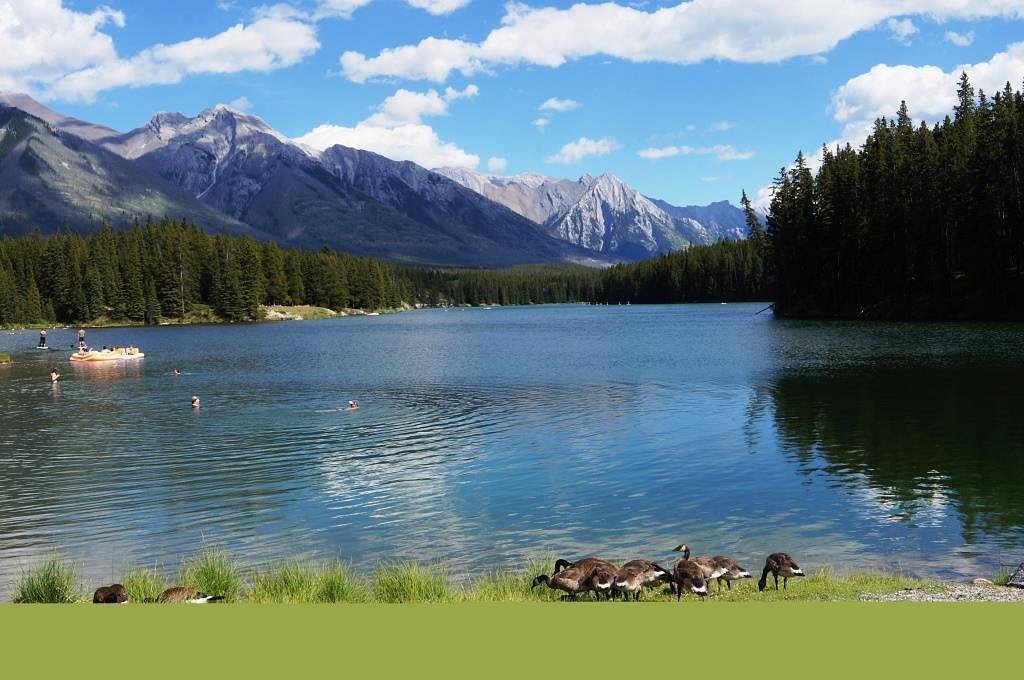
Nestled in the heart of Banff National Park, Johnson Lake is a hidden gem that offers a peaceful and family-friendly kayaking experience. Unlike the more famous Lake Louise and Moraine Lake, Johnson Lake is smaller, quieter, and perfect for those looking for a relaxed paddling adventure. With its calm waters, scenic surroundings, and easy accessibility, Johnson Lake is an ideal destination for beginners, families, and anyone seeking a tranquil escape in nature.
Why Kayak on Johnson Lake?
- Calm Waters: Johnson Lake’s small size and sheltered location make it perfect for beginners and families. The water is calm and easy to navigate, even for first-time kayakers.
- Scenic Beauty: The lake is surrounded by lush forests and offers stunning views of Mount Rundle and the Fairholme Range.
- Less Crowded: Compared to Banff’s more popular lakes, Johnson Lake sees fewer visitors, making it a great spot for a peaceful paddle.
- Wildlife: Keep an eye out for wildlife like beavers, loons, and deer along the shoreline.
What Makes Johnson Lake Special?
- Family-Friendly Atmosphere: Johnson Lake is a favorite among locals and families due to its calm waters and picnic areas.
- Swimming Opportunities: While the water is chilly, the lake has a small beach area where visitors can swim during the summer months.
- Easy Accessibility: The lake is just a short drive from the town of Banff, making it a convenient destination for a quick getaway.
- Historic Charm: The lake was named after Bill Johnson, a local trail guide who built a cabin near the lake in the early 1900s.
Best Time to Kayak on Johnson Lake
The best time to kayak on Johnson Lake is during the summer months (June to September) when the weather is warm, and the lake is free of ice. Early mornings and weekdays are ideal for avoiding crowds.
Kayaking Tips for Johnson Lake
- Rentals: Kayak rentals are not available directly at Johnson Lake, so you’ll need to bring your own kayak or rent one from nearby locations in Banff.
- Permits: No special permits are required for kayaking, but you’ll need a Parks Canada Pass to enter Banff National Park.
- Safety: Always wear a life jacket, even if you’re an experienced paddler. The water is cold, and conditions can change quickly in the mountains.
- Parking: There’s a small parking area near the lake, but it can fill up quickly during peak times. Arrive early to secure a spot.
What to Do Around Johnson Lake
While kayaking is the highlight, there’s plenty more to explore in the area:
- Hiking: The Johnson Lake Loop Trail is an easy, family-friendly hike that circles the lake and offers beautiful views of the water and surrounding mountains.
- Picnicking: The lake has several picnic tables and grassy areas, making it a great spot for a lakeside lunch.
- Swimming: If you’re feeling brave, take a dip in the lake’s chilly waters!
- Photography: The reflections of Mount Rundle on the lake’s surface make for stunning photos, especially at sunrise or sunset.
Find the best hotel deals for your next trip! Compare prices and book your stay on
HostelWorld (Amazing Hostels & Hotels around the world)
TripAdvisor (Compare hotels, read real reviews, and find the best prices)
Why Johnson Lake is a Must-Visit in 2025
Johnson Lake is the perfect destination for those seeking a relaxed and family-friendly kayaking experience in Banff National Park. Its calm waters, scenic beauty, and peaceful atmosphere make it a great alternative to the park’s more crowded lakes. Whether you’re paddling across the lake, hiking the shoreline trail, or enjoying a picnic with your family, Johnson Lake offers an experience that’s both enjoyable and memorable.
As you plan your 2025 kayaking adventures, don’t overlook this hidden gem. Johnson Lake is waiting to welcome you with its tranquil waters and stunning views.
Best Time to Visit Banff National Park
The best time to kayak in Banff National Park is during the summer months, from June to September, when the weather is warm, and the lakes are free of ice. Early mornings are ideal for calm waters and fewer crowds.
Tips for Kayaking in Banff
- Rentals: If you don’t have your own kayak, rentals are available at Lake Louise and other popular spots.
- Permits: While no special permits are required for kayaking, you’ll need a Parks Canada Pass to enter Banff National Park.
- Safety: Always wear a life jacket and be mindful of changing weather conditions, especially in the mountains.
Where to Stay in Banff
After a day of kayaking, relax in comfort at one of Banff’s top accommodations:
Fairmont Chateau Lake Louise: This iconic hotel offers luxurious rooms with stunning views of Lake Louise.
Banff Springs Hotel: Known as the “Castle in the Rockies,” this historic hotel offers a blend of elegance and natural beauty.
Hidden Ridge Resort: For a more rustic experience, stay in one of their cozy cabins with hot tubs and mountain views.
Why Banff Should Be on Your 2025 Kayaking List
Banff National Park is more than just a kayaking destination—it’s an experience that combines adventure, relaxation, and awe-inspiring beauty. Whether you’re paddling on the iconic Lake Louise or exploring the quieter Bow Lake, you’ll leave with memories that last a lifetime.
🌊 2. Pacific Rim National Park Reserve: A Kayaker’s Paradise on Canada’s West Coast
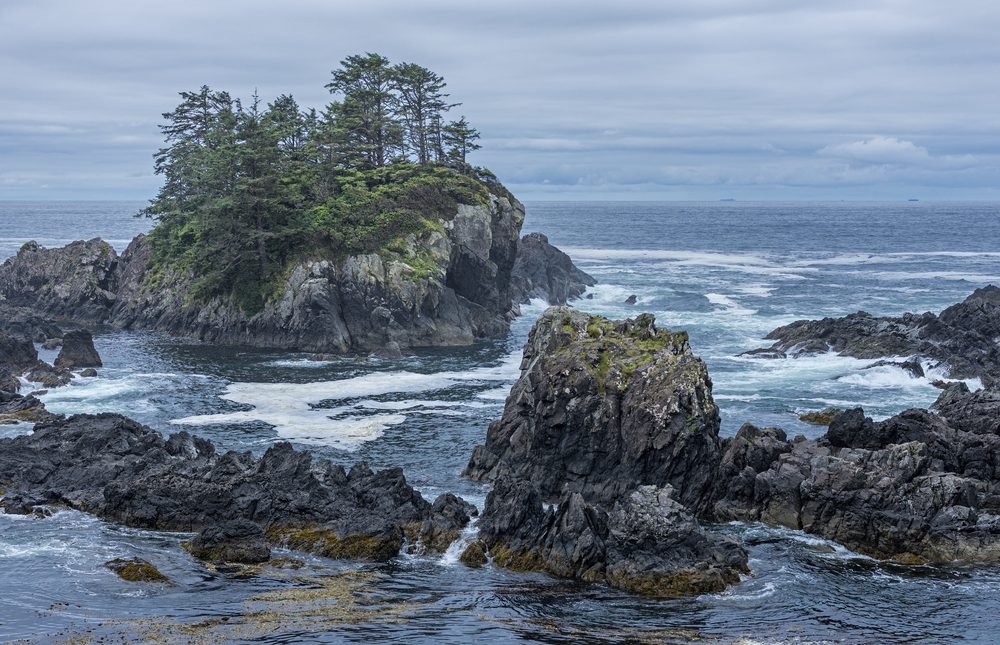
Located on the rugged west coast of Vancouver Island, the Pacific Rim National Park Reserve is a kayaker’s dream destination. This stunning park is divided into three main areas: Long Beach, the Broken Group Islands, and the West Coast Trail. For kayakers, the Broken Group Islands are the crown jewel, offering a unique and unforgettable paddling experience. With its sheltered waters, abundant marine life, and remote island landscapes, the Pacific Rim National Park Reserve is a must-visit for anyone looking to kayak in Canada.
Why Kayak in Pacific Rim National Park Reserve?
- Incredible Scenery: The park’s rugged coastline, dense rainforests, and pristine islands create a breathtaking backdrop for kayaking.
- Abundant Wildlife: Paddle alongside seals, sea lions, otters, and even whales in their natural habitat.
- Sheltered Waters: The Broken Group Islands are protected by the outer islands of Barkley Sound, making them ideal for kayaking, even for beginners.
- Remote Adventure: The park’s remote location offers a true sense of adventure and solitude, perfect for those looking to escape the crowds.
What Makes Pacific Rim National Park Reserve Special?
- Broken Group Islands: This collection of over 100 small islands and islets is a kayaker’s paradise. The calm, sheltered waters make it perfect for multi-day kayaking trips, with plenty of opportunities for camping and exploration.
- Rich Indigenous Culture: The area is part of the traditional territory of the Nuu-chah-nulth First Nations, and visitors can learn about the region’s Indigenous history and culture.
- Diverse Ecosystems: From tidal pools and sandy beaches to old-growth rainforests, the park is home to a wide variety of ecosystems and wildlife.
Best Time to Kayak in Pacific Rim National Park Reserve
The best time to kayak in the Pacific Rim National Park Reserve is during the summer months (June to September) when the weather is mild, and the waters are calm. July and August are particularly popular, but visiting in June or September can help you avoid the crowds.
Kayaking Tips for Pacific Rim National Park Reserve
- Rentals and Tours: If you don’t have your own kayak, you can rent one or join a guided tour from operators in Ucluelet or Tofino.
- Permits: A park permit is required for kayaking and camping in the Broken Group Islands. Be sure to book your campsites in advance, as they fill up quickly during peak season.
- Safety: Always check the weather and tides before heading out. The ocean can be unpredictable, so it’s important to be prepared.
- Wildlife Etiquette: Keep a safe distance from marine animals, especially whales and sea lions, to avoid disturbing them.
Top Kayaking Spots in Pacific Rim National Park Reserve
- Broken Group Islands: This is the park’s premier kayaking destination, offering calm waters, remote campsites, and endless opportunities for exploration.
- Barkley Sound: The sound is home to a variety of marine life and offers stunning views of the surrounding islands and coastline.
- Long Beach: While not ideal for kayaking due to its exposed coastline, Long Beach is a great spot for a scenic paddle along the shore.
What to Do Around Pacific Rim National Park Reserve
While kayaking is the highlight, there’s plenty more to explore in the area:
- Hiking: The Rainforest Trail and Schooner Cove Trail offer easy hikes through lush rainforests and along the coastline.
- Whale Watching: Join a whale-watching tour from Ucluelet or Tofino to see gray whales, humpback whales, and orcas up close.
- Surfing: Long Beach is one of Canada’s best surfing spots, perfect for catching some waves.
- Indigenous Cultural Experiences: Learn about the Nuu-chah-nulth culture through guided tours and cultural programs.
Where to Stay Near Pacific Rim National Park Reserve
The nearby towns of Ucluelet and Tofino offer a range of accommodations:
Black Rock Oceanfront Resort: A luxurious resort in Ucluelet with stunning ocean views.
Wickaninnish Inn: A world-renowned luxury hotel in Tofino, offering unparalleled comfort and service.
Pacific Sands Beach Resort: A family-friendly resort in Tofino with beachfront cabins and suites.
Why Pacific Rim National Park Reserve is a Must-Visit in 2025
The Pacific Rim National Park Reserve offers a kayaking experience like no other. From the sheltered waters of the Broken Group Islands to the rugged beauty of Barkley Sound, this park is a true paradise for paddlers. Whether you’re exploring remote islands, spotting wildlife, or simply soaking in the stunning scenery, the Pacific Rim National Park Reserve promises an adventure you’ll never forget.
As you plan your 2025 kayaking adventures, make sure this incredible destination is on your list. The Pacific Rim National Park Reserve is waiting to welcome you with its wild beauty and endless opportunities for exploration.
🌊 3. Algonquin Provincial Park: A Kayaker’s Dream in Ontario’s Wilderness
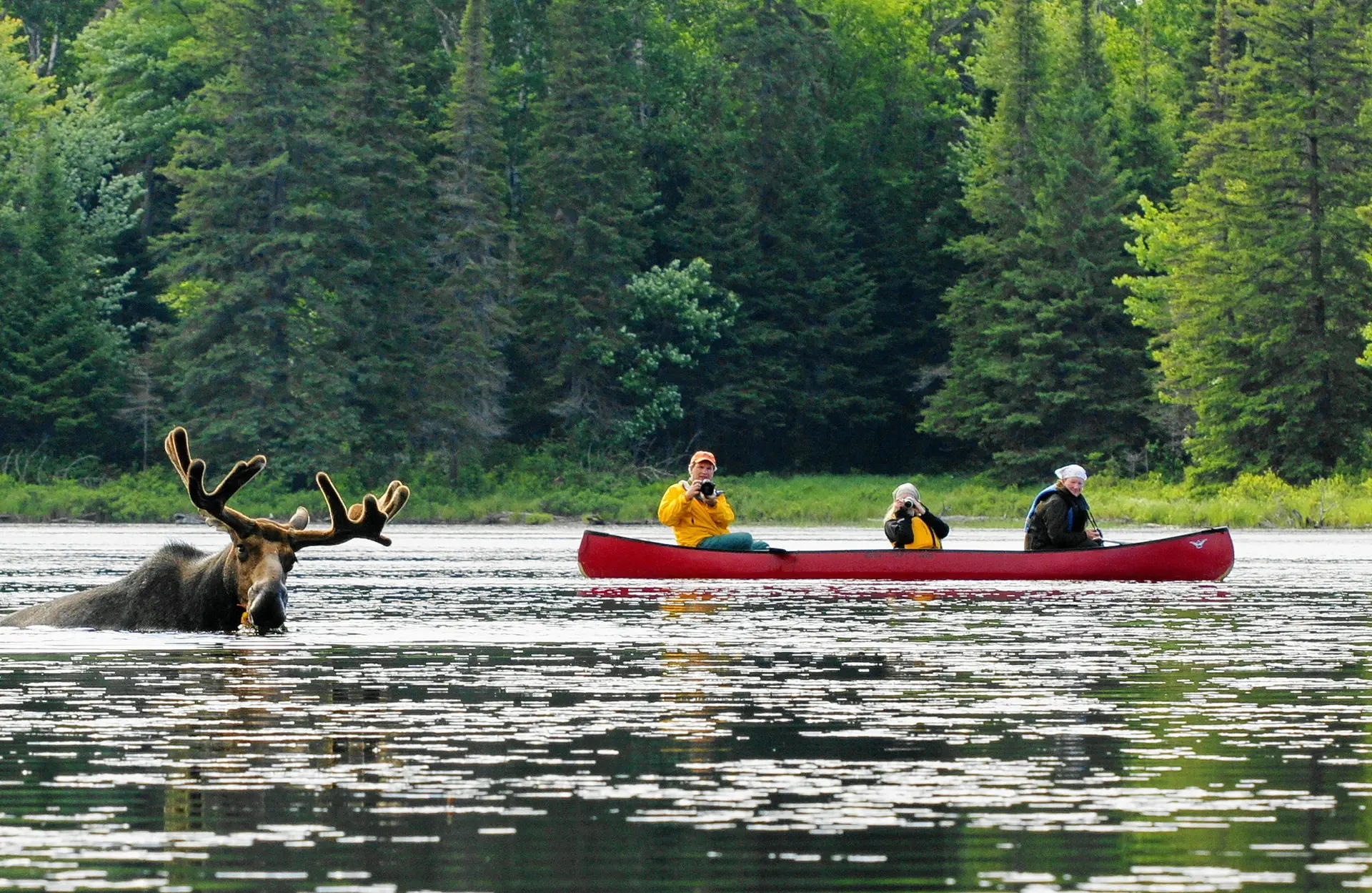
Algonquin Provincial Park, located in Ontario, is one of Canada’s most iconic and beloved outdoor destinations. Spanning over 7,600 square kilometers, this vast park is a haven for kayakers, offering over 2,400 lakes and 1,200 kilometers of rivers and streams to explore. Whether you’re looking for a peaceful day paddle or a multi-day backcountry adventure, Algonquin Provincial Park has something for everyone. With its pristine waters, dense forests, and abundant wildlife, it’s no wonder this park is a top destination for kayaking in Canada.
Why Kayak in Algonquin Provincial Park?
- Endless Waterways: With thousands of lakes and rivers, Algonquin offers endless opportunities for exploration. From small, secluded lakes to larger, interconnected waterways, there’s always something new to discover.
- Stunning Scenery: The park’s rugged landscape, dotted with pine forests, rocky shores, and sandy beaches, creates a breathtaking backdrop for kayaking.
- Wildlife Encounters: Paddle past moose, loons, beavers, and even black bears in their natural habitat.
- Accessibility: Algonquin is easily accessible from major cities like Toronto and Ottawa, making it a convenient destination for a weekend getaway or a longer adventure.
What Makes Algonquin Provincial Park Special?
- Diverse Ecosystems: Algonquin is home to a wide variety of ecosystems, including boreal forests, wetlands, and hardwood forests. This diversity makes it a hotspot for wildlife and nature enthusiasts.
- Rich History: The park has a rich Indigenous and settler history, with evidence of human presence dating back thousands of years.
- Iconic Canoe Routes: While Algonquin is famous for its canoe routes, kayakers can also enjoy these well-marked and maintained waterways.
Best Time to Kayak in Algonquin Provincial Park
The best time to kayak in Algonquin Provincial Park is during the summer months (June to September) when the weather is warm, and the lakes are free of ice. Fall is also a spectacular time to visit, as the park’s forests transform into a sea of red, orange, and yellow.
Find the best hotel deals for your next trip! Compare prices and book your stay on
HostelWorld (Amazing Hostels & Hotels around the world)
TripAdvisor (Compare hotels, read real reviews, and find the best prices)
Kayaking Tips for Algonquin Provincial Park
- Rentals: If you don’t have your own kayak, you can rent one from outfitters in the park, such as Algonquin Outfitters or Portage Store.
- Permits: A park permit is required for day use and camping. Be sure to book your campsites in advance, especially during peak season.
- Safety: Always wear a life jacket and be prepared for changing weather conditions. The park’s lakes can be unpredictable, so it’s important to stay safe.
- Navigation: Bring a map and compass, as some areas of the park have limited cell service.
Top Kayaking Spots in Algonquin Provincial Park
- Canoe Lake: One of the park’s most popular lakes, Canoe Lake offers easy access and stunning scenery. It’s a great spot for beginners and families.
- Opeongo Lake: The park’s largest lake, Opeongo is perfect for experienced kayakers looking for a challenge. The lake’s size and wind can make for exciting paddling conditions.
- Barron Canyon: Located in the park’s quieter east side, Barron Canyon offers dramatic cliffs and serene waters, making it a favorite among kayakers.
- Lake of Two Rivers: This smaller lake is ideal for a relaxing paddle and is a great spot for wildlife viewing.
What to Do Around Algonquin Provincial Park
While kayaking is the highlight, there’s plenty more to explore in the park:
- Hiking: The park has over 14 hiking trails, ranging from easy walks to challenging hikes. Don’t miss the Centennial Ridges Trail or the Track and Tower Trail.
- Camping: Algonquin offers a variety of camping options, from car-accessible campgrounds to remote backcountry sites.
- Wildlife Viewing: Keep an eye out for moose, especially along Highway 60 in the early morning or evening.
- Visitor Center: Learn about the park’s history, wildlife, and ecosystems at the Algonquin Visitor Center.
Where to Stay Near Algonquin Provincial Park
The park offers a range of accommodations, from campsites to lodges:
Arowhon Pines: A rustic yet luxurious lodge located within the park, offering a unique wilderness experience.
Bartlett Lodge: A historic lodge with cozy cabins and excellent dining options.
Algonquin Logging Museum Campground: A great option for those looking to camp near the park’s east side.
Why Algonquin Provincial Park is a Must-Visit in 2025
Algonquin Provincial Park is a kayaker’s dream, offering endless opportunities for exploration and adventure. Whether you’re paddling through serene lakes, spotting wildlife, or hiking through dense forests, Algonquin promises an unforgettable experience. As you plan your 2025 kayaking adventures, make sure this iconic park is on your list. Algonquin Provincial Park is waiting to welcome you with its wild beauty and endless opportunities for exploration.
🌊 4. Gros Morne National Park: A Kayaking Adventure in Newfoundland’s Untamed Wilderness
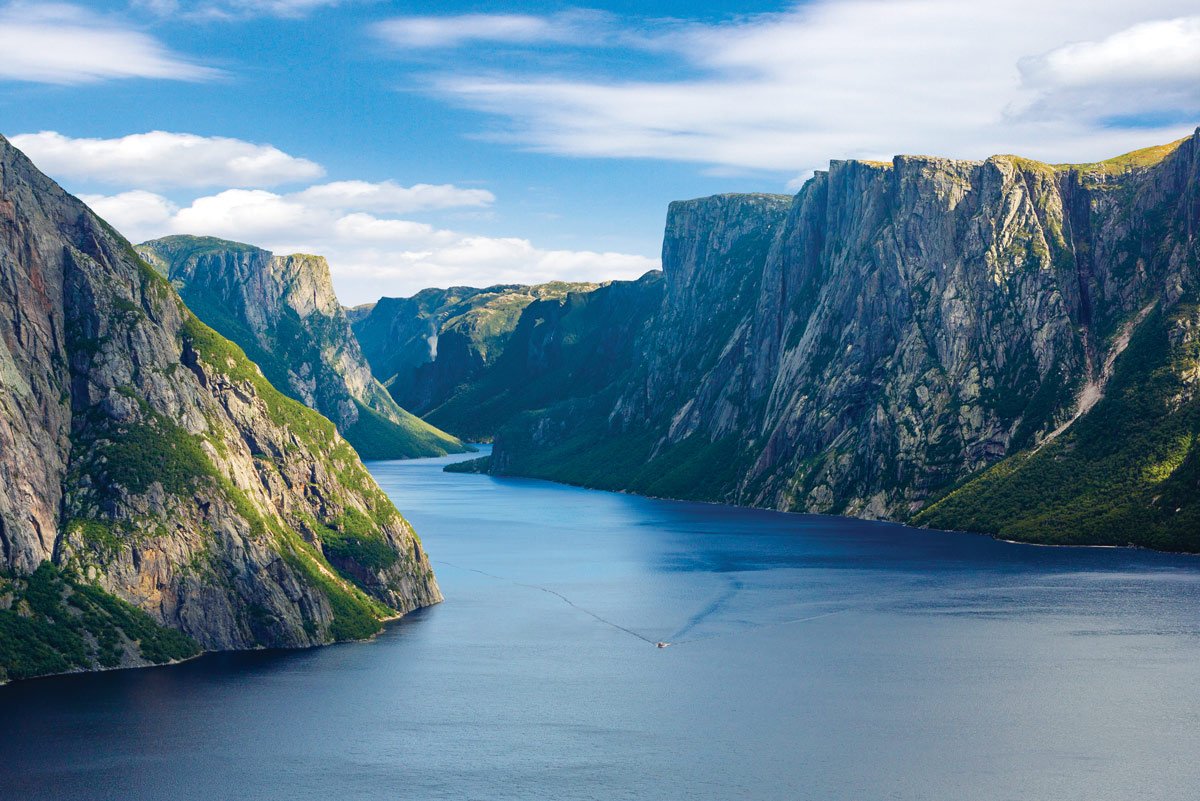
Gros Morne National Park, located on the west coast of Newfoundland and Labrador, is a UNESCO World Heritage Site and one of Canada’s most stunning natural wonders. Known for its dramatic fjords, towering cliffs, and rugged coastline, Gros Morne offers a kayaking experience like no other. Whether you’re paddling through serene fjords, exploring hidden coves, or marveling at the park’s unique geology, Gros Morne National Park is a must-visit destination for kayakers seeking adventure and natural beauty.
Why Kayak in Gros Morne National Park?
- Unique Geology: Gros Morne is famous for its dramatic landscapes, including the Tablelands and Western Brook Pond, a freshwater fjord carved by glaciers.
- Stunning Scenery: Paddle past towering cliffs, cascading waterfalls, and pristine beaches, all set against the backdrop of the Long Range Mountains.
- Wildlife Encounters: Keep an eye out for moose, bald eagles, seals, and even whales as you explore the park’s waterways.
- Remote Adventure: Gros Morne’s remote location offers a true sense of solitude and connection with nature.
What Makes Gros Morne National Park Special?
- Western Brook Pond: This iconic freshwater fjord is one of the park’s most famous landmarks. While motorized boats are not allowed, kayakers can paddle through the fjord’s calm waters and marvel at its towering cliffs.
- Tablelands: This otherworldly landscape is made up of exposed mantle rock, creating a unique and surreal environment.
- Rich Culture: The park is part of the traditional territory of the Mi’kmaq and Beothuk peoples, and visitors can learn about the region’s Indigenous history and culture.
Best Time to Kayak in Gros Morne National Park
The best time to kayak in Gros Morne National Park is during the summer months (June to September) when the weather is mild, and the waters are calm. July and August are particularly popular, but visiting in June or September can help you avoid the crowds.
Kayaking Tips for Gros Morne National Park
- Rentals and Tours: If you don’t have your own kayak, you can rent one or join a guided tour from operators in Norris Point or Rocky Harbour.
- Permits: A park permit is required for kayaking and camping in Gros Morne. Be sure to book your campsites in advance, especially during peak season.
- Safety: Always check the weather and tides before heading out. The ocean can be unpredictable, so it’s important to be prepared.
- Wildlife Etiquette: Keep a safe distance from marine animals, especially whales and seals, to avoid disturbing them.
Top Kayaking Spots in Gros Morne National Park
- Western Brook Pond: This iconic freshwater fjord is a must-visit for kayakers. The calm waters and towering cliffs create a truly unforgettable experience.
- Bonne Bay: This sheltered bay offers calm waters and stunning views of the surrounding mountains. It’s a great spot for beginners and families.
- Trout River Pond: This smaller fjord is less crowded than Western Brook Pond but offers equally stunning scenery.
What to Do Around Gros Morne National Park
While kayaking is the highlight, there’s plenty more to explore in the park:
- Hiking: The park has over 20 hiking trails, ranging from easy walks to challenging hikes. Don’t miss the Gros Morne Mountain Trail or the Green Gardens Trail.
- Boat Tours: Join a boat tour of Western Brook Pond to learn about the park’s geology and history.
- Cultural Experiences: Visit the Discovery Centre in Woody Point to learn about the park’s natural and cultural history.
Where to Stay Near Gros Morne National Park
The nearby towns of Norris Point and Rocky Harbour offer a range of accommodations:
Neddies Harbour Inn: A charming inn in Norris Point with stunning views of Bonne Bay.
Ocean View Hotel: A comfortable and affordable option in Rocky Harbour.
Gros Morne Cabins: Cozy cabins located near the park’s entrance, perfect for a rustic retreat.
Why Gros Morne National Park is a Must-Visit in 2025
Gros Morne National Park offers a kayaking experience like no other. From the dramatic fjords of Western Brook Pond to the serene waters of Bonne Bay, this park is a true paradise for paddlers. Whether you’re exploring remote fjords, spotting wildlife, or simply soaking in the stunning scenery, Gros Morne National Park promises an adventure you’ll never forget.
As you plan your 2025 kayaking adventures, make sure this incredible destination is on your list. Gros Morne National Park is waiting to welcome you with its wild beauty and endless opportunities for exploration.
🌊 5. Thousand Islands: A Kayaking Paradise in Ontario’s St. Lawrence River
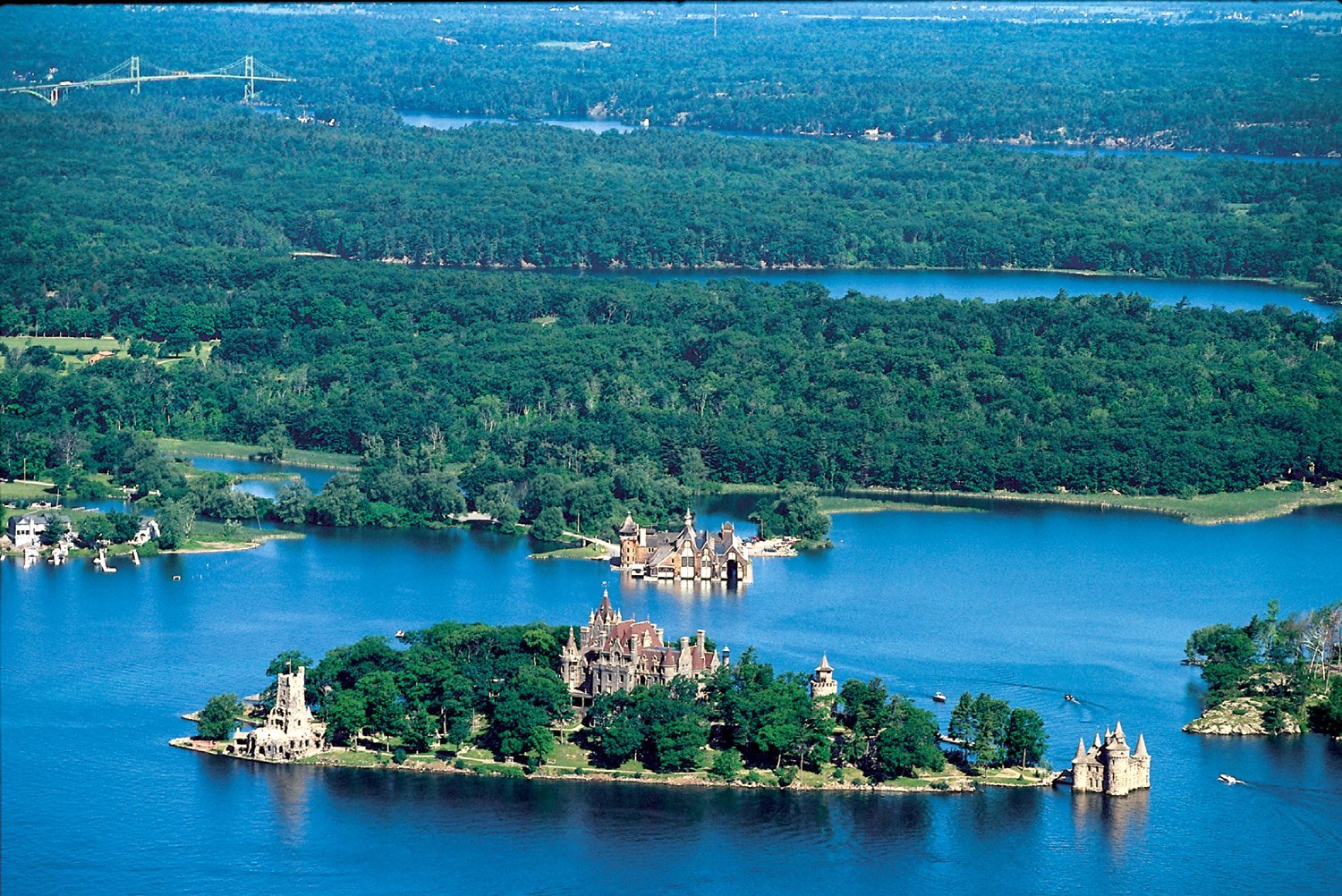
The Thousand Islands region, located along the St. Lawrence River in Ontario, is a kayaker’s dream destination. With over 1,800 islands scattered across the river, this area offers endless opportunities for exploration and adventure. From paddling through narrow channels and discovering hidden coves to marveling at historic castles and lush greenery, the Thousand Islands is a must-visit destination for kayakers of all skill levels.
Why Kayak in the Thousand Islands?
- Endless Exploration: With so many islands to explore, every paddle trip feels like a new adventure.
- Stunning Scenery: The region is known for its crystal-clear waters, lush forests, and charming waterfront cottages.
- Rich History: Paddle past historic landmarks like Boldt Castle and Singer Castle, and learn about the area’s fascinating history.
- Wildlife Encounters: Keep an eye out for bald eagles, ospreys, herons, and even river otters as you explore the waterways.
What Makes the Thousand Islands Special?
- Unique Geography: The Thousand Islands are a mix of Canadian and U.S. territory, with islands ranging from tiny rocky outcrops to larger, inhabited ones.
- Historic Landmarks: The region is home to several historic castles and mansions, including the iconic Boldt Castle on Heart Island.
- Diverse Ecosystems: The area is a haven for wildlife, with wetlands, forests, and rocky shorelines providing habitats for a variety of species.
Best Time to Kayak in the Thousand Islands
The best time to kayak in the Thousand Islands is during the summer months (June to September) when the weather is warm, and the waters are calm. Fall is also a beautiful time to visit, as the surrounding forests burst into vibrant autumn colors.
Kayaking Tips for the Thousand Islands
- Rentals and Tours: If you don’t have your own kayak, you can rent one or join a guided tour from operators in Gananoque, Rockport, or Kingston.
- Permits: No special permits are required for kayaking, but be sure to follow local regulations and respect private property.
- Safety: Always wear a life jacket and be aware of boat traffic, especially in busier areas of the river.
- Navigation: Bring a map or GPS device, as the maze of islands can be confusing to navigate.
Book top-rated tours and attractions on :
Viator (Best for curated global tours)
GetYourGuide (Skip-the-line tickets & local guides)
Klook (Great for Asia adventures & discounts)
Top Kayaking Spots in the Thousand Islands
- Gananoque Area: This popular starting point offers easy access to the islands and plenty of rental options.
- Mallorytown Landing: A quieter area with beautiful scenery and fewer crowds.
- Boldt Castle: Paddle to Heart Island to see the iconic Boldt Castle up close.
- Adolphus Reach: A scenic area with calm waters and plenty of wildlife.
What to Do Around the Thousand Islands
While kayaking is the highlight, there’s plenty more to explore in the area:
- Boat Tours: Join a boat tour to learn about the region’s history and see the islands from a different perspective.
- Hiking: Explore the Thousand Islands National Park trails, which offer stunning views of the river and islands.
- Fishing: The St. Lawrence River is a popular spot for fishing, with species like bass, pike, and muskellunge abundant in the area.
- Dining: Enjoy a meal at one of the many waterfront restaurants in Gananoque or Kingston.
Where to Stay Near the Thousand Islands
The region offers a range of accommodations, from cozy inns to luxurious resorts:
Gananoque Inn and Spa: A charming inn with waterfront views and a full-service spa.
1000 Islands Harbor Hotel: A luxurious hotel in Clayton, NY, with stunning views of the river.
Rockport Cruises and Accommodations: A great option for those looking to stay close to the water.
Why the Thousand Islands is a Must-Visit in 2025
The Thousand Islands offers a kayaking experience like no other. With its endless islands, stunning scenery, and rich history, this region is a true paradise for paddlers. Whether you’re exploring hidden coves, spotting wildlife, or marveling at historic castles, the Thousand Islands promises an adventure you’ll never forget.
As you plan your 2025 kayaking adventures, make sure this incredible destination is on your list. The Thousand Islands are waiting to welcome you with their natural beauty and endless opportunities for exploration.
🌊 6. Clayoquot Sound: A Kayaker’s Paradise on Vancouver Island’s Wild Coast
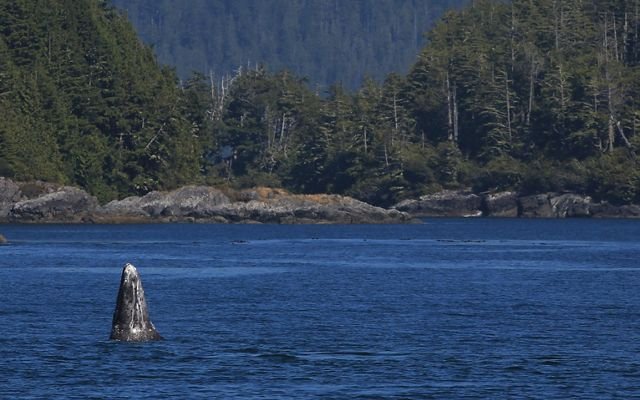
Clayoquot Sound, located on the west coast of Vancouver Island in British Columbia, is a UNESCO Biosphere Reserve and one of the most stunning kayaking destinations in Canada. Known for its ancient rainforests, rugged coastline, and remote islands, Clayoquot Sound offers a truly immersive wilderness experience. Whether you’re paddling through calm inlets, exploring hidden beaches, or spotting whales and sea otters, Clayoquot Sound is a must-visit destination for kayakers seeking adventure and natural beauty.
Why Kayak in Clayoquot Sound?
- Untouched Wilderness: Clayoquot Sound is one of the last remaining temperate rainforests in the world, offering a pristine and remote kayaking experience.
- Abundant Wildlife: Paddle alongside gray whales, sea otters, seals, and bald eagles in their natural habitat.
- Stunning Scenery: The sound’s calm waters, towering trees, and rugged coastline create a breathtaking backdrop for kayaking.
- Cultural Richness: The area is part of the traditional territory of the Nuu-chah-nulth First Nations, and visitors can learn about the region’s Indigenous history and culture.
What Makes Clayoquot Sound Special?
- UNESCO Biosphere Reserve: Clayoquot Sound is recognized for its ecological significance and efforts to balance conservation with sustainable development.
- Ancient Rainforests: The sound is home to some of the oldest and tallest trees in Canada, including ancient cedars and Sitka spruces.
- Remote Islands: The sound’s many islands, such as Meares Island and Flores Island, offer endless opportunities for exploration.
Best Time to Kayak in Clayoquot Sound
The best time to kayak in Clayoquot Sound is during the summer months (June to September) when the weather is mild, and the waters are calm. July and August are particularly popular, but visiting in June or September can help you avoid the crowds.
Kayaking Tips for Clayoquot Sound
- Rentals and Tours: If you don’t have your own kayak, you can rent one or join a guided tour from operators in Tofino or Ucluelet.
- Permits: No special permits are required for kayaking, but be sure to follow local regulations and respect private property.
- Safety: Always check the weather and tides before heading out. The ocean can be unpredictable, so it’s important to be prepared.
- Wildlife Etiquette: Keep a safe distance from marine animals, especially whales and sea otters, to avoid disturbing them.
Top Kayaking Spots in Clayoquot Sound
- Meares Island: Home to the Big Tree Trail, this island offers a unique kayaking experience with its ancient rainforests and calm waters.
- Flores Island: Known for the Ahousaht Wild Side Heritage Trail, Flores Island is a great spot for a multi-day kayaking trip.
- Hot Springs Cove: Paddle to this remote cove and relax in the natural hot springs, surrounded by stunning scenery.
- Tofino Inlet: A sheltered area with calm waters, perfect for beginners and families.
What to Do Around Clayoquot Sound
While kayaking is the highlight, there’s plenty more to explore in the area:
- Hiking: Explore the Big Tree Trail on Meares Island or the Wild Side Heritage Trail on Flores Island.
- Whale Watching: Join a whale-watching tour from Tofino or Ucluelet to see gray whales, humpback whales, and orcas up close.
- Surfing: Tofino is one of Canada’s best surfing spots, perfect for catching some waves.
- Indigenous Cultural Experiences: Learn about the Nuu-chah-nulth culture through guided tours and cultural programs.
Where to Stay Near Clayoquot Sound
The nearby towns of Tofino and Ucluelet offer a range of accommodations:
Wickaninnish Inn: A luxurious hotel in Tofino with stunning ocean views.
Black Rock Oceanfront Resort: A modern resort in Ucluelet with beautiful oceanfront suites.
Clayoquot Wilderness Lodge: A remote and luxurious lodge located within Clayoquot Sound, offering a true wilderness experience.
Why Clayoquot Sound is a Must-Visit in 2025
Clayoquot Sound offers a kayaking experience like no other. From its ancient rainforests and remote islands to its abundant wildlife and rich cultural heritage, this region is a true paradise for paddlers. Whether you’re exploring hidden beaches, spotting whales, or simply soaking in the stunning scenery, Clayoquot Sound promises an adventure you’ll never forget.
🌊 7. Jasper National Park: A Kayaking Adventure in the Heart of the Canadian Rockies
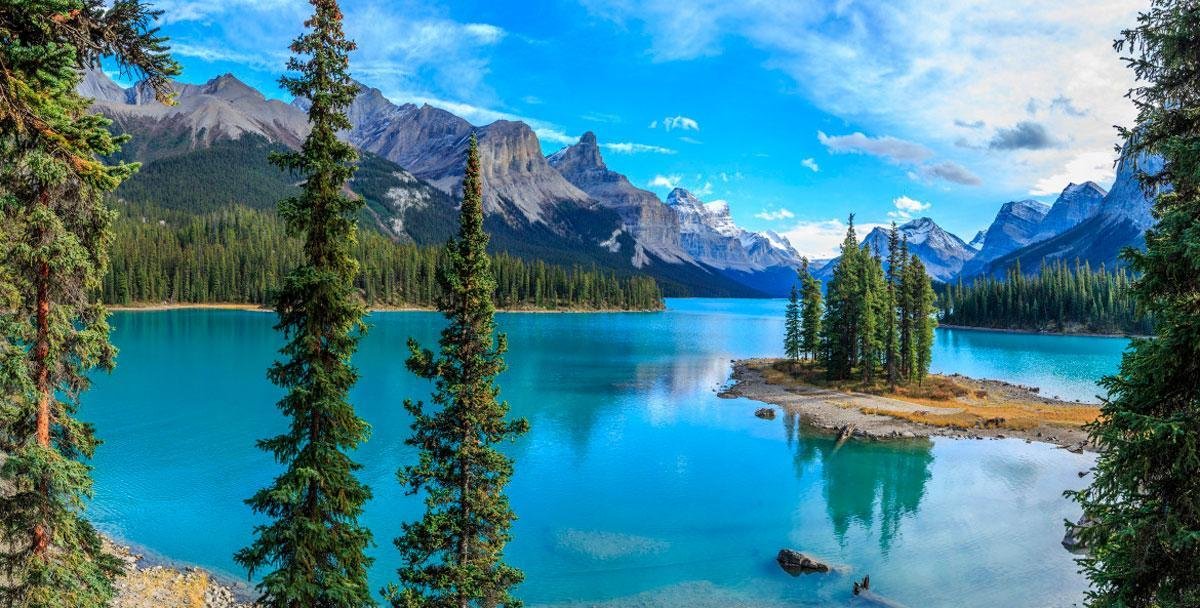
Jasper National Park, located in Alberta’s Canadian Rockies, is a UNESCO World Heritage Site and one of Canada’s most stunning natural wonders. Known for its rugged mountains, pristine lakes, and abundant wildlife, Jasper offers a kayaking experience that combines adventure, tranquility, and breathtaking scenery. Whether you’re paddling on crystal-clear lakes, exploring serene rivers, or marveling at towering peaks, Jasper National Park is a must-visit destination for kayakers of all skill levels.
Why Kayak in Jasper National Park?
- Stunning Scenery: The park’s turquoise lakes, rugged mountains, and dense forests create a breathtaking backdrop for kayaking.
- Diverse Waterways: From calm lakes to flowing rivers, Jasper offers a variety of paddling options for all skill levels.
- Wildlife Encounters: Keep an eye out for elk, moose, bald eagles, and even grizzly bears as you explore the park’s waterways.
- Peaceful Atmosphere: Jasper is less crowded than Banff, offering a more tranquil and immersive experience.
What Makes Jasper National Park Special?
- Maligne Lake: One of the most iconic lakes in the Canadian Rockies, Maligne Lake is famous for its vibrant blue waters and Spirit Island.
- Athabasca River: This scenic river offers a mix of calm sections and mild rapids, perfect for a relaxing paddle or a bit of adventure.
- Dark Sky Preserve: Jasper is the world’s second-largest Dark Sky Preserve, making it a great spot for stargazing after a day on the water.
- Rich Wildlife: The park is home to a wide variety of wildlife, including bighorn sheep, wolves, and black bears.
Best Time to Kayak in Jasper National Park
The best time to kayak in Jasper National Park is during the summer months (June to September) when the weather is warm, and the lakes are free of ice. Early mornings are ideal for calm waters and fewer crowds.
Kayaking Tips for Jasper National Park
- Rentals: If you don’t have your own kayak, you can rent one from outfitters in Jasper, such as Jasper Adventure Centre or Maligne Lake Boathouse.
- Permits: No special permits are required for kayaking, but you’ll need a Parks Canada Pass to enter the park.
- Safety: Always wear a life jacket and be prepared for changing weather conditions, especially in the mountains.
- Wildlife Etiquette: Keep a safe distance from wildlife and store food securely to avoid attracting animals.
Top Kayaking Spots in Jasper National Park
- Maligne Lake: This iconic lake is a must-visit for kayakers. Paddle to Spirit Island for one of the most photographed views in the Canadian Rockies.
- Pyramid Lake: Located just outside the town of Jasper, Pyramid Lake offers calm waters and stunning views of Pyramid Mountain.
- Athabasca River: This scenic river is perfect for a relaxing paddle or a bit of adventure, with mild rapids and beautiful scenery.
- Medicine Lake: Known as the “Disappearing Lake,” Medicine Lake offers a unique kayaking experience with its fluctuating water levels.
What to Do Around Jasper National Park
While kayaking is the highlight, there’s plenty more to explore in the park:
- Hiking: The park has over 1,200 kilometers of hiking trails, ranging from easy walks to challenging hikes. Don’t miss the Skyline Trail or the Valley of the Five Lakes.
- Wildlife Viewing: Join a wildlife tour or explore on your own to spot elk, moose, and bears.
- Hot Springs: Relax in the Miette Hot Springs, the hottest springs in the Canadian Rockies.
- Scenic Drives: Take a drive along the Icefields Parkway, one of the most scenic drives in the world.
Where to Stay Near Jasper National Park
The town of Jasper offers a range of accommodations, from cozy lodges to luxurious resorts:
Fairmont Jasper Park Lodge: A luxurious resort with stunning lake views and world-class amenities.
Pyramid Lake Resort: A cozy resort located on the shores of Pyramid Lake, perfect for a peaceful retreat.
Jasper Downtown Hostel: A budget-friendly option in the heart of Jasper, offering easy access to the park’s attractions.
Why Jasper National Park is a Must-Visit in 2025
Jasper National Park offers a kayaking experience like no other. From the iconic Maligne Lake to the serene Pyramid Lake, this park is a true paradise for paddlers. Whether you’re exploring remote lakes, spotting wildlife, or simply soaking in the stunning scenery, Jasper National Park promises an adventure you’ll never forget.
🌊 8. Bay of Fundy: A Kayaking Adventure with the World’s Highest Tides
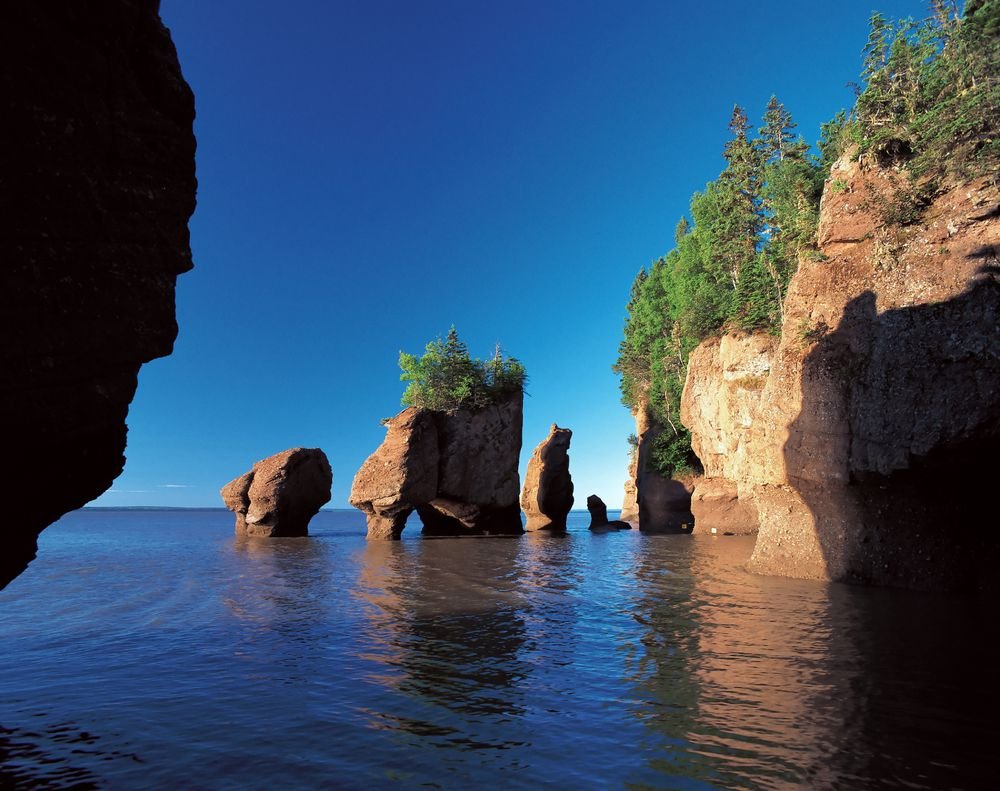
The Bay of Fundy, located between New Brunswick and Nova Scotia, is a natural wonder and one of the most unique kayaking destinations in Canada. Known for having the highest tides in the world, the Bay of Fundy offers a kayaking experience that is both thrilling and awe-inspiring. Whether you’re paddling through sea caves, exploring rugged coastlines, or witnessing the dramatic tidal changes, the Bay of Fundy is a must-visit destination for kayakers seeking adventure and natural beauty.
Why Kayak in the Bay of Fundy?
- Unique Tidal Phenomenon: The Bay of Fundy’s tides can rise and fall by up to 16 meters (52 feet), creating a dynamic and ever-changing landscape.
- Stunning Scenery: Paddle past towering cliffs, sea stacks, and dramatic rock formations, including the iconic Hopewell Rocks.
- Abundant Wildlife: Keep an eye out for seals, porpoises, bald eagles, and even whales as you explore the bay.
- Thrilling Adventure: The bay’s strong tides and currents offer a thrilling challenge for experienced kayakers.
What Makes the Bay of Fundy Special?
- Hopewell Rocks: These iconic flowerpot-shaped rock formations are a must-see. Paddle around them at high tide or explore the ocean floor at low tide.
- Fundy National Park: Located on the New Brunswick side of the bay, this park offers stunning coastal scenery and a variety of outdoor activities.
- Rich Marine Life: The bay’s nutrient-rich waters support a diverse ecosystem, making it a hotspot for wildlife enthusiasts.
Best Time to Kayak in the Bay of Fundy
The best time to kayak in the Bay of Fundy is during the summer months (June to September) when the weather is mild, and the waters are calm. Be sure to check the tide schedules, as the timing of your paddle can greatly affect your experience.
Kayaking Tips for the Bay of Fundy
- Guided Tours: Due to the bay’s strong tides and currents, it’s recommended to join a guided tour, especially if you’re not an experienced kayaker.
- Safety: Always wear a life jacket and be aware of the tides and weather conditions. The bay’s waters can be unpredictable.
- Tide Schedules: Plan your paddle around the tides to make the most of your experience. High tide is ideal for exploring sea caves, while low tide reveals fascinating tidal pools and rock formations.
- Wildlife Etiquette: Keep a safe distance from marine animals, especially whales and seals, to avoid disturbing them.
Top Kayaking Spots in the Bay of Fundy
- Hopewell Rocks: Paddle around these iconic rock formations at high tide for a truly unique experience.
- St. Martins Sea Caves: Explore the sea caves and arches along the rugged coastline near the village of St. Martins.
- Fundy National Park: The park’s coastal waters offer stunning scenery and plenty of opportunities for exploration.
- Deer Island: This island offers calm waters and beautiful scenery, perfect for a relaxing paddle.
What to Do Around the Bay of Fundy
While kayaking is the highlight, there’s plenty more to explore in the area:
- Hiking: Explore the coastal trails in Fundy National Park or the Fundy Footpath, one of the most challenging hikes in the region.
- Whale Watching: Join a whale-watching tour to see humpback whales, fin whales, and minke whales up close.
- Tidal Bore Rafting: Experience the thrill of riding the tidal bore, a wave caused by the incoming tide.
- Cultural Experiences: Visit the charming villages of Alma and St. Martins to learn about the region’s history and culture.
Find the best hotel deals for your next trip! Compare prices and book your stay on
HostelWorld (Amazing Hostels & Hotels around the world)
TripAdvisor (Compare hotels, read real reviews, and find the best prices)
Why the Bay of Fundy is a Must-Visit in 2025
The Bay of Fundy offers a kayaking experience like no other. From its dramatic tides and rugged coastlines to its abundant wildlife and unique rock formations, this region is a true paradise for paddlers. Whether you’re exploring sea caves, spotting whales, or simply soaking in the stunning scenery, the Bay of Fundy promises an adventure you’ll never forget.
🌊 9. Rideau Canal: A Serene Kayaking Journey Through Ontario’s Historic Waterway
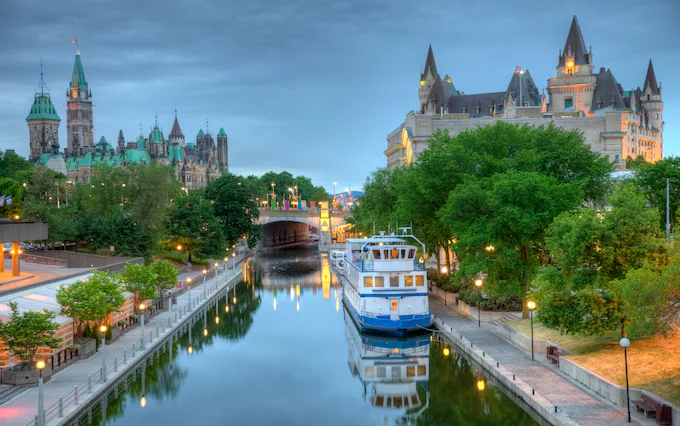
The Rideau Canal, a UNESCO World Heritage Site, is one of Ontario’s most iconic and picturesque waterways. Stretching over 202 kilometers (126 miles) from Ottawa to Kingston, the canal offers a unique kayaking experience that combines natural beauty, rich history, and charming towns. Whether you’re paddling through tranquil lakes, navigating historic locks, or exploring quaint villages, the Rideau Canal is a must-visit destination for kayakers seeking a blend of adventure and relaxation.
Why Kayak on the Rideau Canal?
- Historic Charm: The Rideau Canal is the oldest continuously operated canal system in North America, offering a glimpse into Canada’s past.
- Scenic Beauty: Paddle through a mix of serene lakes, winding rivers, and lush forests, all set against the backdrop of Ontario’s countryside.
- Accessible Adventure: The canal’s calm waters and well-maintained locks make it ideal for kayakers of all skill levels.
- Charming Towns: Explore quaint towns and villages along the canal, each with its own unique character and attractions.
What Makes the Rideau Canal Special?
- UNESCO World Heritage Site: The canal is recognized for its historical significance and engineering marvel, including its 47 locks.
- Diverse Landscapes: The canal passes through a variety of landscapes, from urban areas in Ottawa to rural countryside and pristine lakes.
- Rich History: Built in the early 19th century for military purposes, the canal now serves as a recreational waterway and a living museum.
Best Time to Kayak on the Rideau Canal
The best time to kayak on the Rideau Canal is during the summer months (June to September) when the weather is warm, and the canal is fully operational. Early mornings and weekdays are ideal for avoiding crowds.
Kayaking Tips for the Rideau Canal
- Rentals: If you don’t have your own kayak, you can rent one from outfitters in Ottawa, Smiths Falls, or Kingston.
- Permits: No special permits are required for kayaking, but you’ll need to pay a small fee if you plan to use the locks.
- Safety: Always wear a life jacket and be aware of boat traffic, especially in busier sections of the canal.
- Navigation: Bring a map or GPS device, as the canal can be confusing to navigate in some areas.
Top Kayaking Spots on the Rideau Canal
- Dow’s Lake (Ottawa): Start your journey in the heart of Ottawa, paddling through this scenic lake surrounded by parks and gardens.
- Merrickville: Known as the “Jewel of the Rideau,” this charming village offers beautiful scenery and historic architecture.
- Big Rideau Lake: The largest lake on the canal, Big Rideau Lake offers calm waters and stunning views, perfect for a relaxing paddle.
- Jones Falls: This historic lock station is surrounded by beautiful scenery and offers a great spot for a break.
What to Do Around the Rideau Canal
While kayaking is the highlight, there’s plenty more to explore along the canal:
- Cycling: The Rideau Trail offers a scenic route for cyclists, following the canal from Ottawa to Kingston.
- Fishing: The canal is home to a variety of fish species, including bass, pike, and walleye.
- Historic Sites: Visit the Bytown Museum in Ottawa or the Rideau Canal Museum in Smiths Falls to learn about the canal’s history.
- Dining: Enjoy a meal at one of the many waterfront restaurants in towns like Merrickville and Westport.
Where to Stay Near the Rideau Canal
The canal offers a range of accommodations, from cozy inns to luxurious resorts:
The Fairmont Château Laurier: A luxurious hotel in Ottawa with stunning views of the canal.
The Cove Country Inn: A charming inn located on the shores of Westport, offering beautiful views and cozy accommodations.
The Opinicon: A historic resort on the shores of Lake Opinicon, perfect for a relaxing retreat.
Why the Rideau Canal is a Must-Visit in 2025
The Rideau Canal offers a kayaking experience like no other. From its historic locks and charming towns to its serene lakes and lush forests, this waterway is a true paradise for paddlers. Whether you’re exploring the urban sections in Ottawa or the rural stretches near Kingston, the Rideau Canal promises an adventure you’ll never forget.
As you plan your 2025 kayaking adventures, make sure this incredible destination is on your list. The Rideau Canal is waiting to welcome you with its natural beauty and rich history.
🌊 10. Haida Gwaii: A Remote Kayaking Adventure in Canada’s Pacific Edge

Haida Gwaii, formerly known as the Queen Charlotte Islands, is an archipelago off the coast of British Columbia that offers one of the most remote and mystical kayaking experiences in Canada. Known for its ancient rainforests, rich Indigenous culture, and abundant wildlife, Haida Gwaii is a destination for those seeking a true off-the-beaten-path adventure. Whether you’re paddling through pristine waters, exploring Haida cultural sites, or witnessing the region’s unique ecosystems, Haida Gwaii is a must-visit destination for kayakers looking to connect with nature and history.
Why Kayak in Haida Gwaii?
- Untouched Wilderness: Haida Gwaii is one of the most remote and pristine regions in Canada, offering a true wilderness experience.
- Rich Indigenous Culture: The islands are the traditional territory of the Haida Nation, and visitors can explore ancient village sites and learn about Haida culture.
- Abundant Wildlife: Paddle alongside whales, sea lions, otters, and a variety of seabirds in their natural habitat.
- Unique Ecosystems: The islands are home to unique flora and fauna, including the Haida Gwaii black bear and ancient Sitka spruce trees.
What Makes Haida Gwaii Special?
- Gwaii Haanas National Park Reserve: This protected area encompasses the southern part of Haida Gwaii and is a UNESCO World Heritage Site. It’s known for its ancient Haida village sites, including SGang Gwaay (Ninstints), and its stunning natural beauty.
- Ancient Rainforests: The islands are home to some of the oldest and tallest trees in Canada, including ancient cedars and Sitka spruces.
- Rich Marine Life: The waters around Haida Gwaii are teeming with marine life, making it a hotspot for wildlife enthusiasts.
Best Time to Kayak in Haida Gwaii
The best time to kayak in Haida Gwaii is during the summer months (June to September) when the weather is mild, and the waters are calm. July and August are particularly popular, but visiting in June or September can help you avoid the crowds.
Kayaking Tips for Haida Gwaii
- Guided Tours: Due to the remote and challenging nature of the area, it’s recommended to join a guided tour, especially if you’re not an experienced kayaker.
- Permits: A park permit is required for kayaking and camping in Gwaii Haanas National Park Reserve. Be sure to book your permits in advance.
- Safety: Always check the weather and tides before heading out. The ocean can be unpredictable, so it’s important to be prepared.
- Wildlife Etiquette: Keep a safe distance from marine animals, especially whales and sea lions, to avoid disturbing them.
Top Kayaking Spots in Haida Gwaii
- Gwaii Haanas National Park Reserve: This protected area offers some of the best kayaking in Haida Gwaii, with calm waters, ancient village sites, and stunning scenery.
- Hecate Strait: Paddle through this strait for a chance to see whales and other marine life up close.
- Ramsay Island: This small island offers calm waters and beautiful scenery, perfect for a relaxing paddle.
- Skidegate Inlet: This sheltered inlet is a great spot for beginners and families, with calm waters and stunning views.
While kayaking is the highlight, there’s plenty more to explore in the area:
- Cultural Tours: Join a guided tour to learn about the Haida Nation’s history and culture, and visit ancient village sites like SGang Gwaay (Ninstints).
- Hiking: Explore the islands’ many hiking trails, including the Balance Rock Trail and the Tow Hill Trail.
- Fishing: The waters around Haida Gwaii are teeming with fish, including salmon, halibut, and rockfish.
- Wildlife Viewing: Join a wildlife tour to see whales, sea lions, and a variety of seabirds up close.
Where to Stay Near Haida Gwaii
The islands offer a range of accommodations, from cozy lodges to luxurious resorts:
Ocean View Cabins: Cozy cabins located on the shores of Skidegate Inlet, offering stunning views and easy access to the water.
Haida House at Tllaal: A luxurious lodge offering a unique cultural experience, with guided tours and traditional Haida cuisine.
Queen B Guesthouse: A budget-friendly option in the heart of Queen Charlotte City, offering comfortable accommodations and easy access to the islands’ attractions.
Why Haida Gwaii is a Must-Visit in 2025
Haida Gwaii offers a kayaking experience like no other. From its ancient rainforests and rich Indigenous culture to its abundant wildlife and remote islands, this region is a true paradise for paddlers. Whether you’re exploring ancient village sites, spotting whales, or simply soaking in the stunning scenery, Haida Gwaii promises an adventure you’ll never forget.
As you plan your 2025 kayaking adventures, make sure this incredible destination is on your list. Haida Gwaii is waiting to welcome you with its wild beauty and rich cultural heritage.
🌟 10 Best Places To Kayak In Canada: In Conclusion
Kayaking in Canada is more than just an activity—it’s a way to connect with nature and create lasting memories. Whether you’re exploring the turquoise waters of Banff or the rugged coastlines of Haida Gwaii, each destination offers a unique experience. As you plan your kayaking adventures for 2025, don’t forget to book your accommodations through WayAway.io, Trip.com, or Agoda.com for the best deals on hotels and resorts.
So, what are you waiting for? Start planning your trip to these 10 Best Places To Kayak In Canada and get ready for the adventure of a lifetime!
If you have any questions, leave a comment below or send me a message!
Read More .....
- Oman Travel Budget: How Much Does It Cost To Travel Oman?
- The Ultimate 2-Week Oman Road Trip Itinerary (2025)
- Camping In Oman: Everything You Need To Know
- A Perfect Muscat Itinerary: 10 Best Things to Do
- 4 Days In Dubai: The Ultimate Dubai Itinerary And City Guide
- Dubai Hot Air Balloon: Soar Above the Desert in Style
- The Perfect 3 Days Abu Dhabi Itinerary: Your Ultimate Travel Guide
